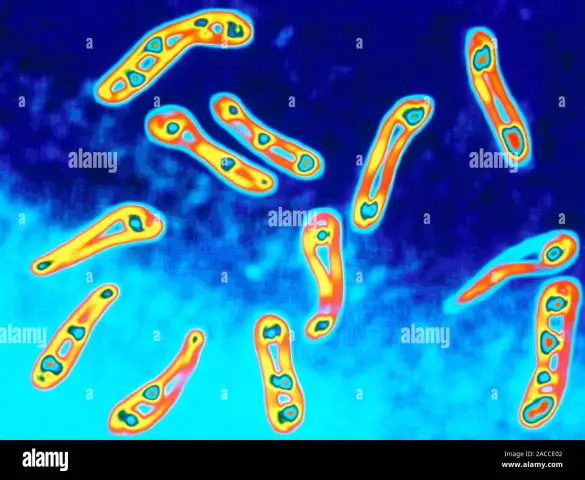- Author Curtis Blomfield [email protected].
- Public 2023-12-16 20:44.
- Last modified 2025-01-23 17:01.
The causative agent of diphtheria, better known in medicine as Corynebacterium diphtheriae, was discovered and then successfully isolated on nutrient media in pure culture 100 years ago. At the same time, after several years of active study, its role in the onset and pathological development of an infectious disease was established. This became possible only after obtaining a specific toxin that the bacterium produces. It causes the death of the experimental animal, which develops pathological symptoms similar to those observed in patients with diphtheria.

The causative agent of diphtheria belongs to the genus Corynebacterium. But at the same time, it is assigned to a separate group of coryneform bacteria. These are slightly curved sticks, which have extensions or points at the ends. They also have an atypical division, they seem to break in two, while acquiringcharacteristic arrangement in the form of the Latin letter V. But in the studied smears, one can also see single, isolated sticks. The causative agent of diphtheria is a relatively large bacterium, its length reaches 8 microns. They do not have flagella, they do not form protective capsules. Another important property of the diphtheria bacillus is the ability to form very strong toxins.

All types of corynebacteria are facultative anaerobes. They thrive with or without oxygen. Resistant to drying, although they do not have spores. If a pure culture is exposed to heating at 60 degrees, it will be destroyed within one hour. And in pathological materials, that is, if they have protein protection, the causative agent of diphtheria is able to maintain its vital activity from 40 to 60 minutes. at a temperature of 90 degrees. As for low temperatures, no detrimental effect on these microorganisms is observed. At normal concentrations in disinfectants, bacteria quickly die.

The causative agent of diphtheria is also characterized by high polymorphism. It manifests itself not only in changes in the thickness parameters, but also in a change in the shape itself. In smears, branching, filiform, segmented, swollen and flask-shaped sticks are distinguished. At the same time, thickening can be seen at their ends on both sides after 12 hours from the beginning of culture growth, the bacterium takes the form of a dumbbell. In these thickenings with specialstaining reveals the so-called Babesh-Ernst grains (clusters of currency grains).
Diphtheria pathogens are saprophytes. They belong to those microorganisms that constantly need organic substances. That is why the nutrient media used for growing this microbe in the laboratory must certainly include amino acids in its composition. It can be cystine, alanine, methionine, valine. Elective media for corynebacteria are those containing serum, blood, or ascitic fluid. Based on this, Leffler's culture medium was first developed, followed by Tyndall's and Clauberg's.






